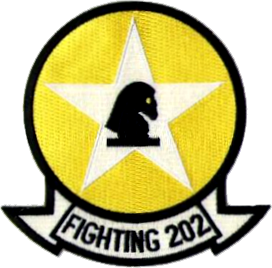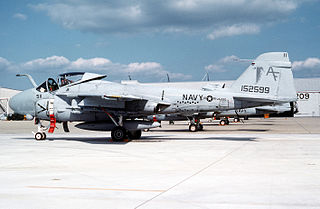
The VFA-201, Strike Fighter Squadron was an aviation unit of the United States Naval Reserve based at Naval Air Station Joint Reserve Base Fort Worth, Texas (USA). It was established in 1970 as part of Reserve Carrier Air Wing 20 (CVWR-20) and deactivated in 2007. During its service VFA-201 could be identified by the tail code "AF" and nose numbers (MODEX) in the "100" series, typically 100 to 113. The squadron's nickname was the Hunters.

Fighter Squadron Composite 13 (VFC-13), also known as the "Fighting Saints", is a fighter squadron of the United States Navy Reserve that provides adversary training at NAS Fallon, Nevada. VFC-13 uses "Bogey" as its main radio callsign.

Fighter Squadron Composite 12 (VFC-12), also known as the "Fighting Omars", is a United States Navy Reserve fighter squadron based at NAS Oceana. It provides adversary training to East Coast Navy air wings. VFC-12 reports to Tactical Support Wing, a component of the Naval Air Force Reserve. The "Fighting Omars" are manned by selected reservists, full-time reservists (FTS) and active duty personnel.

A carrier air wing is an operational naval aviation organization composed of several aircraft squadrons and detachments of various types of fixed-wing and rotary-wing aircraft. Organized, equipped and trained to conduct modern US Navy carrier air operations while embarked aboard aircraft carriers, the various squadrons in an air wing have different but complementary missions, and provide most of the striking power and electronic warfare capabilities of a carrier battle group (CVBG). While the CVBG term is still used by other nations, the CVBG in US parlance is now known as a carrier strike group (CSG).

Strike Fighter Squadron 34 (VFA-34), also known as the "Blue Blasters", is a United States Navy F/A-18E Super Hornet strike fighter squadron stationed at Naval Air Station Oceana. They are a part of Carrier Air Wing 11 and are attached to the aircraft carrier USS Theodore Roosevelt. Their tail code is NH and their radio call sign is "Joker".

Fighter Squadron 202 (VF-202) nicknamed the Superheats was an aviation unit of the United States Naval Reserve initially based at Naval Air Station Dallas, Texas. Following that installation's BRAC-directed closure, the squadron relocated to nearby former Carswell Air Force Base, which was transferred to U.S. Navy control according to BRAC action and renamed Naval Air Station Joint Reserve Base Fort Worth / Carswell Field. VF-202 was established on 1 July 1970 as part of Reserve Carrier Air Wing 20 (CVWR-20), the U.S. Atlantic Fleet's reserve carrier air wing, and disestablished on 31 December 1994. During its service VF-202 could be identified by the tail code "AF" and nose numbers (MODEX) "200" through "213."

Strike Fighter Squadron 125 (VFA-125), also known as the "Rough Raiders", is a United States Navy strike fighter squadron based at Naval Air Station Lemoore, California. The "Rough Raiders" are a Fleet Replacement Squadron flying the F-35C Lightning II.

Naval Air Station Cecil Field or NAS Cecil Field was a United States Navy air base, located in Duval County, Florida. Prior to October 1999, NAS Cecil Field was the largest military base in terms of acreage in the Jacksonville, Florida area.

Fighter Squadron Composite 111 (VFC-111), also known as the "Sun Downers", is a United States Navy Reserve adversary squadron based at Naval Air Station Key West, Florida. Currently, it operates Northrop F-5N/F Tiger-IIs, of which most are single-seater F-5Ns and one twin-seater F-5F, the "FrankenTiger".

A modex is a number that is part of the Aircraft Visual Identification System, along with the aircraft's tail code. It usually consists of two or three numbers that the Department of the Navy, U.S. Navy and U.S. Marine Corps use on aircraft to identify a squadron's mission and a specific aircraft within a squadron. These numbers are painted conspicuously on the aircraft's nose—or, on helicopters, sometimes on the aft portion of the fuselage or forward portion of the empennage. Modexes are also painted less conspicuously on other aircraft areas. Shore-based aviation units use either two-digit or three-digit modexes, while carrier-based units always use three digits.

Fighter Squadron Composite 204 (VFC-204), also known as the "River Rattlers", is a United States Navy Reserve adversary squadron, slated to fly the F-5N/F Tiger II after having previously flown the F/A-18C/D Hornet. The squadron is based out of Naval Air Station Joint Reserve Base New Orleans, Louisiana, and is part of the U.S. Navy Reserve's Tactical Support Wing. Their radio callsign is "River" and their tail code is "AF".

Strike Fighter Wing, U.S. Atlantic Fleet (SFWL) is the U.S. Navy's largest type wing with 18 squadrons flying more than 300 aircraft composed of six different variants of the F/A-18 Hornet and Super Hornet. The wing, based at NAS Oceana, is also home to the east coast F/A-18 Fleet Replacement Squadron (FRS) which trains pilots and Weapon Systems Officers (WSOs) in the Hornet and Super Hornet before they are assigned to operational fleet squadrons. The fleet squadrons deploy as part of Carrier Air Wings (CVWs) on aircraft carriers on both the east and west coasts.

VA-205, nicknamed the Green Falcons, was an Attack Squadron of the U.S. Naval Reserve, based at Naval Air Station Atlanta, Georgia. It was established on 1 July 1970 and disestablished on 31 December 1994.

Carrier Air Wing Thirteen (CVW-13) was a carrier air wing of the United States Navy established for a short period at the end of the Cold War. There were three previous units which had been named Carrier Air Group Thirteen (CVG-13), dating as far back as 1942, though each of these units has a distinct lineage.
In 1989, the United States Navy was on the verge of massive cuts to military spending cuts including ship and aircraft procurement. These forces were expected to fight the Soviet Union, Warsaw Pact and other potential adversaries in case of a war breaking out. At this time, the USS Kitty Hawk (CV-63) of the Pacific Fleet was out of commission for Service Life Extension Program (SLEP) modernization leaving the 3rd Fleet with less carriers.



















